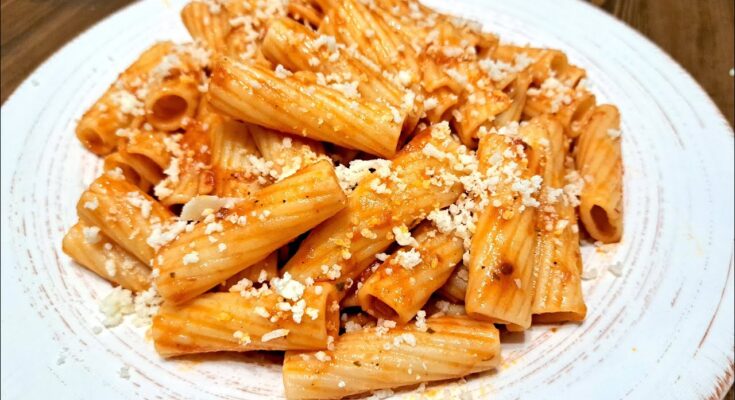Rigatoni Recipe: Rigatoni is a classic tube-shaped pasta that hails from central and southern Italy. Unlike penne or ziti, rigatoni has ridges along the sides and is slightly curved, making it the perfect vessel for catching hearty sauces and chunky ingredients. The name “rigatoni” comes from the Italian word “rigare,” which means “to stripe or groove”—a nod to its distinct ridged texture.
Rigatoni is a versatile pasta that can be used in everything from creamy tomato dishes to baked casseroles. Its sturdy structure allows it to hold up well under heat, making it a popular choice for baked pasta recipes that require time in the oven. If you’re a pasta lover who enjoys rich, flavorful sauces, rigatoni might just be your new favorite.
Why Choose Rigatoni for Your Pasta Dish?
So, what makes rigatoni a standout among other pasta shapes? It’s all in the design. The hollow center and ridged surface are like sauce magnets—each bite becomes a flavor-packed experience. Whether you’re working with a meat-based ragù or a simple garlic and olive oil combo, rigatoni can handle it.
Another reason to love rigatoni is its chew. It provides that satisfying bite that keeps you going back for more. And when baked with cheese or layered with vegetables, rigatoni offers a heartiness that’s hard to beat. It’s also a family-friendly pasta—kids love it, and it pairs beautifully with just about any ingredient in your pantry.
Ingredients You’ll Need
Rigatoni Pasta
Start with high-quality rigatoni pasta. If possible, go for the bronze-cut varieties that have a rougher texture. This allows the sauce to cling better to the surface, enhancing each bite. For a standard serving size, you’ll need about 1 pound (16 oz) of rigatoni, which typically serves four people.
Look for rigatoni that has a strong, golden hue and doesn’t break easily in the package. Cooking it al dente is key—this means the pasta is tender but still has a bit of a bite in the center. Al dente rigatoni holds its shape better and gives a more authentic Italian experience.
Key Ingredients for the Sauce
The sauce can make or break your rigatoni dish, and this recipe keeps it flavorful yet simple:
- 2 tablespoons olive oil
- 1 small onion, finely chopped
- 3 cloves garlic, minced
- 1 pound ground beef or Italian sausage
- 1 can (28 oz) crushed tomatoes
- 1 tablespoon tomato paste
- 1 teaspoon dried oregano
- 1 teaspoon salt
- ½ teaspoon black pepper
- A pinch of red pepper flakes (optional for heat)
- ½ cup grated Parmesan cheese
- Fresh basil leaves for garnish
These ingredients combine to create a rich, meaty tomato sauce that clings beautifully to the rigatoni. Feel free to swap the protein or go meatless based on your preference.
Optional Add-ins for Extra Flavor
Want to jazz things up? Here are a few extras you can throw into the mix:
- Mushrooms: Sauté with onions for earthy depth.
- Spinach or Kale: Stir in during the last few minutes of simmering for a health boost.
- Heavy cream or ricotta: Add for a creamier, luxurious texture.
- Mozzarella cubes: Toss in before serving or baking for gooey, melty goodness.
These add-ins are totally optional but can elevate your dish from simple to stunning depending on your mood or occasion.
Essential Tools and Prep Tips
Kitchen Tools You’ll Need
Here’s what you’ll need to bring this recipe to life:
- Large pot for boiling pasta
- Skillet or saucepan for cooking the sauce
- Wooden spoon or spatula
- Colander for draining pasta
- Cheese grater
- Measuring spoons and cups
- Optional: Oven-safe dish if you plan to bake it
Having everything prepped and ready before you start will save time and help you focus on flavor.
Prep Tips for a Seamless Cooking Experience
Before you fire up the stove, make sure all your ingredients are chopped, measured, and ready to go. This “mise en place” approach (a fancy French term for prepping ahead) ensures that you’re not scrambling while the onions are browning or the pasta is boiling.
- Bring water to a rolling boil before adding salt and pasta.
- Grate the Parmesan fresh—pre-shredded cheese doesn’t melt as smoothly.
- If using fresh herbs, chop them last to preserve their fragrance.
Once you’re organized, cooking rigatoni becomes a joy rather than a chore.
Step-by-Step Rigatoni Recipe
Step 1: Boiling the Rigatoni
Fill a large pot with water—at least 4 to 6 quarts for every pound of pasta. Salt the water generously (think salty like the sea). This is your one chance to flavor the pasta itself. Once the water is boiling, add the rigatoni and stir occasionally to prevent sticking.
Cook the pasta until al dente, usually around 10–12 minutes depending on the brand. Taste a piece near the end—you’re looking for a firm bite with no chalky center. Once done, drain the pasta and set aside. Don’t rinse it—you want that starch to help the sauce cling!
Step 2: Preparing the Sauce
Now it’s time to build flavor—the heart and soul of any rigatoni recipe. Grab your skillet or large saucepan and place it over medium heat. Pour in the olive oil, and once it’s shimmering, toss in the chopped onions. Cook them down for about 5–7 minutes until they become translucent and start to caramelize just a little. This sweetness adds a beautiful depth to your sauce.
Next, stir in the minced garlic. Let it cook for about 30 seconds—just until fragrant. Be careful not to burn it, as garlic can go bitter fast.
Add your ground beef or Italian sausage (or a combo of both, if you’re feeling indulgent). Break it up with a wooden spoon as it browns. You want even, crumbled pieces with a little caramelization for extra flavor. Once the meat is no longer pink, drain any excess fat if needed—but leave a little for richness.
Now, stir in the tomato paste and cook it out for 2 minutes to remove its raw taste. Then add the crushed tomatoes, oregano, salt, black pepper, and optional red pepper flakes. Mix everything together, lower the heat, and let the sauce simmer for 20–25 minutes. Stir occasionally and watch it thicken and intensify in flavor.
Before finishing, toss in the grated Parmesan cheese and stir to melt. This adds a nutty, salty element that balances the acidity of the tomatoes. Want to kick it up? Add a splash of cream or a spoonful of ricotta for a creamy twist.
Step 3: Combining Pasta and Sauce
Once your sauce is thick and aromatic, it’s time for the magic moment—marrying pasta with sauce. Don’t just spoon sauce over pasta; instead, add the drained rigatoni straight into the pan with the sauce. Turn the heat to low and gently toss everything together so every tube is coated in rich, savory goodness.
This technique—finishing pasta in the sauce—helps the flavors infuse into the rigatoni, rather than sitting on top. Add a splash of reserved pasta water (about ¼ cup) to loosen things if needed. That starchy water helps bind the sauce to the noodles and makes the dish silky.
Let it cook together for 2–3 minutes, stirring gently. This ensures the rigatoni absorbs some of the sauce, intensifying the flavor with every bite.
If you’re going baked-style, transfer the combined pasta and sauce into an oven-safe dish. Top with mozzarella cheese and a sprinkle of more Parmesan. Bake at 375°F (190°C) for 20 minutes or until golden and bubbly.
Step 4: Finishing Touches and Serving Tips
Now that you’ve got this incredible rigatoni ready, let’s plate it up like a pro. Grab a deep plate or pasta bowl—something that holds heat well and cradles the saucy goodness. Ladle a generous portion of rigatoni into the bowl.
Garnish with freshly chopped basil or parsley for a burst of color and freshness. Drizzle with a little extra virgin olive oil or a touch more Parmesan if you’re feeling fancy. You could even top it with some crushed red pepper or cracked black pepper for added spice and aroma.
Want to make it a meal? Serve it with a simple green salad dressed in lemon and olive oil or a warm piece of garlic bread to mop up every drop of that delicious sauce.
This rigatoni dish is best enjoyed hot, straight out of the pan or oven, with people you love around the table. But honestly? Even leftover rigatoni the next day is pure gold.
Variations and Customizations
Vegetarian Rigatoni
If you’re looking for a meatless version that doesn’t skimp on flavor, you’re in luck. You can swap out the meat for a blend of sautéed mushrooms, zucchini, and bell peppers. These veggies absorb the sauce beautifully and give a hearty texture that’ll keep even carnivores satisfied.
Start by cooking the veggies just like you would the meat—first onions and garlic, then your chopped vegetables. Add the crushed tomatoes and spices, simmer, and proceed as usual. A spoonful of ricotta stirred in at the end makes it extra creamy.
Bonus tip: Roasting your vegetables first before adding them to the sauce intensifies their flavor like crazy.
Spicy Sausage Rigatoni
If you love a kick, spicy sausage rigatoni will become your new obsession. Use hot Italian sausage or even chorizo. As it cooks, it releases oils infused with spices that completely elevate your tomato base.
Add a teaspoon of smoked paprika or cayenne for even more heat. A little splash of red wine into the sauce can deepen the flavor and give it that restaurant-quality richness.
Pair this spicy rigatoni with a glass of bold red wine and you’ve got yourself a five-star dinner without leaving the house.
Baked Rigatoni with Cheese
Looking for comfort food heaven? Enter: baked rigatoni with cheese. After combining your rigatoni and sauce, layer it in a baking dish with shredded mozzarella, Parmesan, and even ricotta in between the layers.
Bake it uncovered for about 20–25 minutes until the top is golden, crispy, and bubbly. Let it rest for 5 minutes before serving so everything sets just right.
The contrast of crispy cheese on top and gooey sauce below is exactly what comfort food dreams are made of.
FAQs about Rigatoni Recipe
1. What ingredients do I need for a basic rigatoni recipe?
To whip up a classic rigatoni dish, you’ll need rigatoni pasta, olive oil, garlic, canned tomatoes, fresh basil, salt, pepper, and grated Parmesan cheese. Optional ingredients include ground meat, vegetables, or spicy red pepper flakes for an extra kick.
2. How long does it take to cook rigatoni pasta?
Rigatoni typically takes about 10-13 minutes to cook in boiling water. However, always check the package for specific cooking times, and taste a piece to ensure it’s al dente, which means it’s cooked through but still has a slight firmness.
3. Can I make rigatoni gluten-free?
Absolutely! Gluten-free rigatoni is readily available in most grocery stores. Just replace the regular rigatoni with a gluten-free version made from rice, corn, or quinoa flour.
4. What’s the best way to store leftover rigatoni?
Leftover rigatoni can be stored in an airtight container in the refrigerator for up to three days. To reheat, simply sprinkle some water over the top and microwave it for a few minutes or reheat it on the stove over low heat.
5. Can rigatoni be used in vegetarian or vegan recipes?
Rigatoni is incredibly versatile and can easily be adapted for vegetarian or vegan diets. Use plant-based cheeses and meats, or load up on veggies like spinach, mushrooms, and bell peppers for a hearty, plant-based meal.
Conclusion
Rigatoni is more than just another pasta shape—it’s a canvas for creativity. Whether you go classic with a meaty tomato sauce or spin it vegetarian with rich, creamy textures, rigatoni holds its own and then some. From stovetop to oven-baked, each variation brings out a new side of this beloved pasta.
With this step-by-step guide, you’ve got everything you need to whip up a soul-warming meal that’s as comforting as it is satisfying. The next time you’re staring into your pantry wondering what to cook, remember: rigatoni’s got your back.



